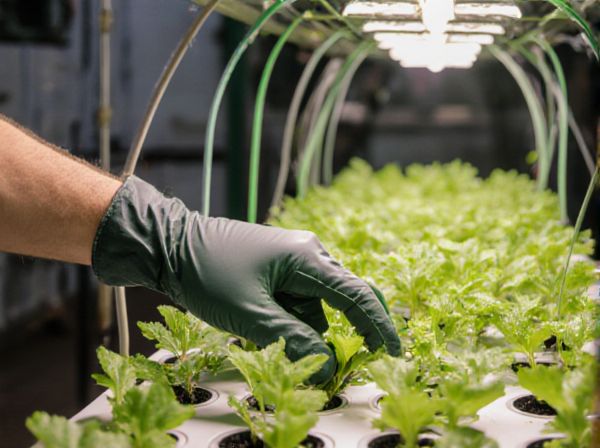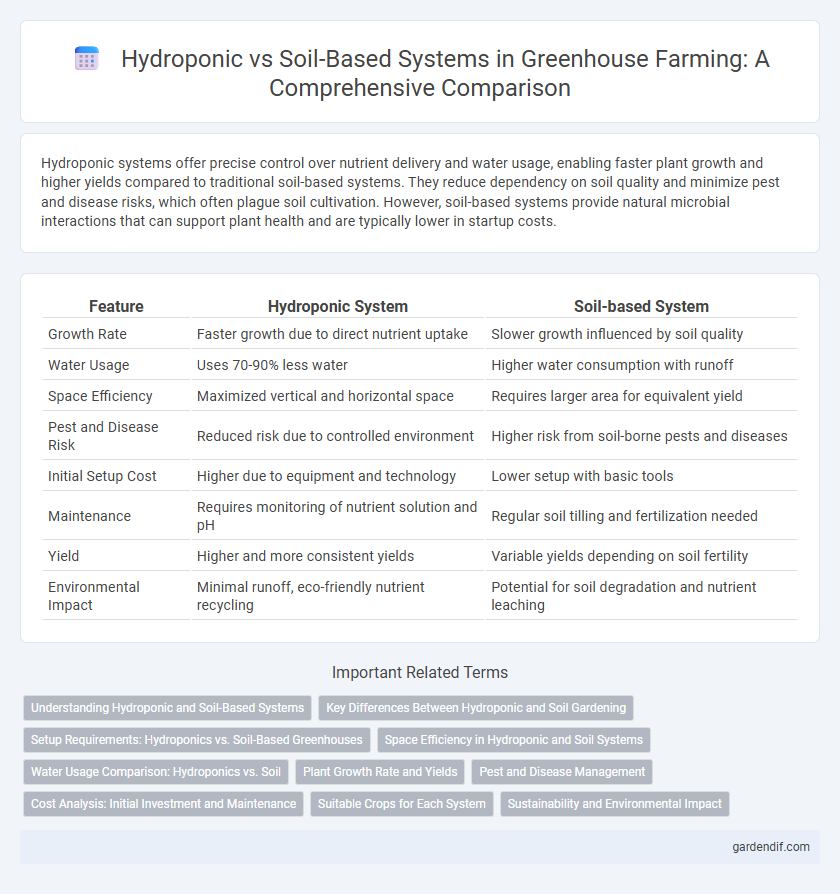
Hydroponic system vs Soil-based system Illustration
Hydroponic systems offer precise control over nutrient delivery and water usage, enabling faster plant growth and higher yields compared to traditional soil-based systems. They reduce dependency on soil quality and minimize pest and disease risks, which often plague soil cultivation. However, soil-based systems provide natural microbial interactions that can support plant health and are typically lower in startup costs.
Table of Comparison
| Feature | Hydroponic System | Soil-based System |
|---|---|---|
| Growth Rate | Faster growth due to direct nutrient uptake | Slower growth influenced by soil quality |
| Water Usage | Uses 70-90% less water | Higher water consumption with runoff |
| Space Efficiency | Maximized vertical and horizontal space | Requires larger area for equivalent yield |
| Pest and Disease Risk | Reduced risk due to controlled environment | Higher risk from soil-borne pests and diseases |
| Initial Setup Cost | Higher due to equipment and technology | Lower setup with basic tools |
| Maintenance | Requires monitoring of nutrient solution and pH | Regular soil tilling and fertilization needed |
| Yield | Higher and more consistent yields | Variable yields depending on soil fertility |
| Environmental Impact | Minimal runoff, eco-friendly nutrient recycling | Potential for soil degradation and nutrient leaching |
Understanding Hydroponic and Soil-Based Systems
Hydroponic systems use nutrient-rich water solutions to grow plants without soil, enabling faster growth rates and higher yields in controlled greenhouse environments. Soil-based systems rely on natural soil properties for nutrient uptake, which can lead to variable growth due to soil quality and microbial activity. Understanding the differences in nutrient delivery, water usage, and environmental control is crucial for optimizing plant health and productivity in greenhouse cultivation.
Key Differences Between Hydroponic and Soil Gardening
Hydroponic systems use nutrient-rich water solutions to grow plants without soil, enabling faster growth rates and higher yields compared to traditional soil-based gardening. Soil gardening relies on natural soil composition, which provides organic matter and microorganisms essential for plant health but can be less efficient due to variable nutrient availability and pest issues. Hydroponic setups offer precise control over nutrient delivery and pH levels, reducing water usage and minimizing environmental impact relative to soil cultivation.
Setup Requirements: Hydroponics vs. Soil-Based Greenhouses
Hydroponic systems in greenhouses demand precise control over water quality, nutrient delivery, and environmental factors such as temperature and humidity, often requiring specialized equipment like pumps, reservoirs, and grow lights. In contrast, soil-based greenhouses focus on soil preparation, pest management, and irrigation, with simpler infrastructure but higher dependency on soil health and natural nutrient cycles. Both systems need adequate ventilation and structural support, but hydroponics offers a more controlled environment leading to potentially faster plant growth and higher yield optimization.
Space Efficiency in Hydroponic and Soil Systems
Hydroponic systems maximize space efficiency by allowing vertical stacking and dense plant arrangements, enabling higher crop yields per square meter compared to soil-based systems. Soil-based cultivation requires larger spacing to accommodate root expansion and prevent nutrient competition, limiting planting density. This efficient use of limited greenhouse space makes hydroponics ideal for urban farming and controlled environment agriculture.
Water Usage Comparison: Hydroponics vs. Soil
Hydroponic systems use up to 90% less water than traditional soil-based cultivation by recycling nutrient solutions and minimizing evaporation. Soil-based farming often experiences significant water loss due to runoff, deep percolation, and evaporation, leading to inefficient water use. Hydroponics delivers water directly to plant roots, ensuring precise hydration and maximizing resource efficiency in greenhouse environments.
Plant Growth Rate and Yields
Hydroponic systems enable plants to grow up to 25-50% faster than soil-based systems due to efficient nutrient delivery and controlled environmental conditions. Yields in hydroponic greenhouses can increase by 30-50%, as continuous monitoring reduces nutrient deficiencies and optimizes water use. Soil-based systems often face limitations from soil quality and pests, resulting in slower growth and lower overall production.
Pest and Disease Management
Hydroponic systems reduce pest exposure by eliminating soil, which is a common habitat for many insects and pathogens, thereby minimizing disease incidence. Controlled environments in hydroponic greenhouses allow for precise monitoring and rapid intervention against pests, enhancing plant health. Soil-based systems face higher risks of soil-borne diseases and pests, requiring more frequent chemical treatments and crop rotation strategies to manage infestations.
Cost Analysis: Initial Investment and Maintenance
Hydroponic systems typically demand a higher initial investment due to specialized equipment like pumps, grow media, and nutrient delivery systems, whereas soil-based systems rely on more traditional, less costly materials such as soil and basic tools. Maintenance costs for hydroponics can be lower over time as water usage is more efficient and pests are easier to control, but nutrient solutions and equipment repairs may add to expenses. Soil-based systems often incur higher ongoing costs related to soil amendments, watering, and pest management, making overall cost analysis dependent on specific crop types and production scales.
Suitable Crops for Each System
Hydroponic systems excel in growing leafy greens, herbs, and strawberries due to their controlled nutrient delivery and water efficiency, enabling faster growth and higher yields in limited spaces. Soil-based systems are better suited for root vegetables like carrots and potatoes, as well as crops requiring extensive root space such as tomatoes and melons, benefiting from natural soil nutrients and microbial diversity. Selecting the appropriate system depends on the crop's root structure, nutrient needs, and space availability within the greenhouse environment.
Sustainability and Environmental Impact
Hydroponic systems use up to 90% less water than soil-based systems by recirculating nutrient solutions, significantly reducing water waste and conserving resources. Soil-based agriculture often leads to soil degradation and erosion, releasing stored carbon and harming biodiversity, whereas hydroponics minimizes land use and soil disturbance. The controlled environment of hydroponics also reduces the need for pesticides and herbicides, lowering chemical runoff and environmental contamination.
Hydroponic system vs Soil-based system Infographic

 gardendif.com
gardendif.com